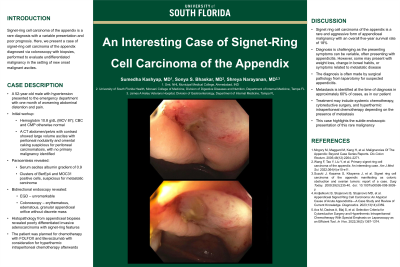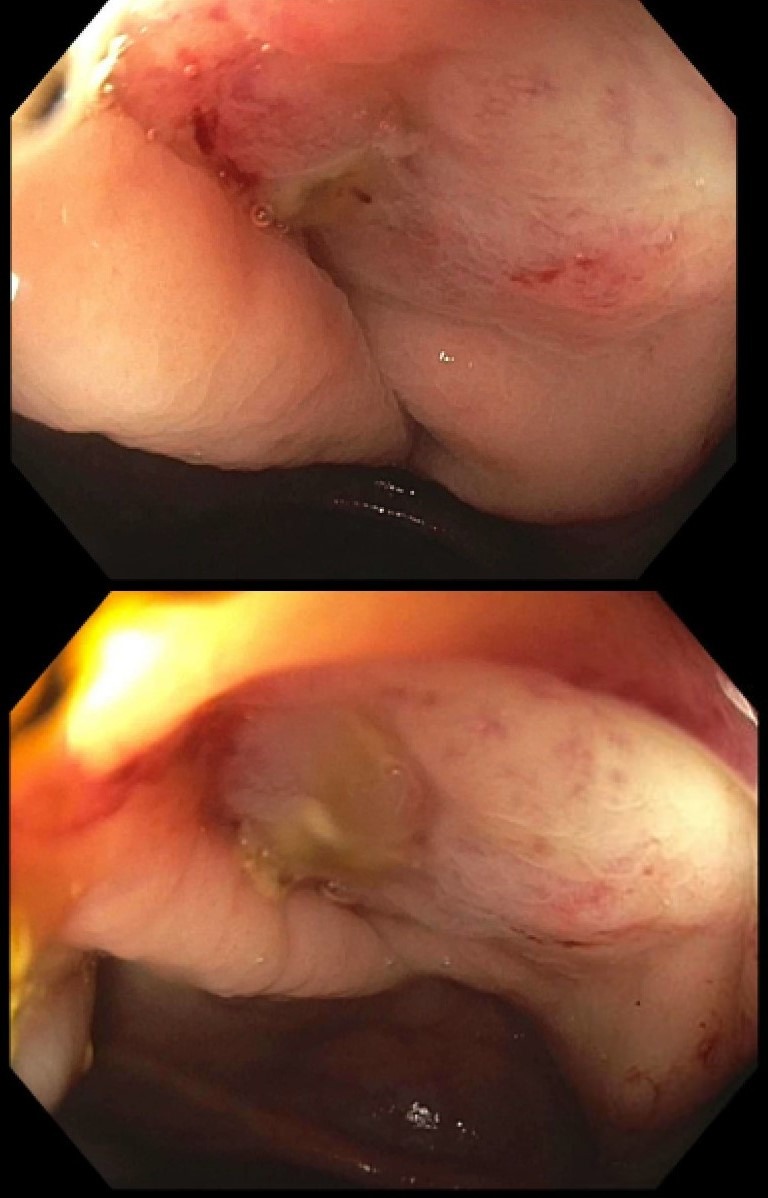Sunday Poster Session
Category: Colon
P0331 - An Interesting Case of Signet Ring Cell Carcinoma of the Appendix
Sunday, October 27, 2024
3:30 PM - 7:00 PM ET
Location: Exhibit Hall E

Has Audio

Sumedha Kashyap, MBBS
Smt. NHL Municipal Medical College
Tampa, FL
Presenting Author(s)
Sumedha Kashyap, MBBS1, Sonya Bhaskar, MD2, Shreya Narayanan, MD2
1Smt. NHL Municipal Medical College, Tampa, FL; 2University of South Florida, Tampa, FL
Introduction: Signet-ring cell carcinoma of the appendix is an extremely rare diagnosis with a variable presentation and poor prognosis. Here we present a case of signet-ring cell carcinoma diagnosed via colonoscopy with biopsies, performed for evaluation of undifferentiated malignancy in the context of new onset malignant ascites.
Case Description/Methods: A 52-year-old male with hypertension presented to the emergency department with one month of worsening abdominal distention and pain. Vital signs on presentation were normal. Initial lab studies revealed a hemoglobin of 10.8 g/dL (MCV 87) but complete blood count with differential and complete metabolic panel were otherwise normal. Contrasted CT of the abdomen and pelvis showed large volume ascites with peritoneal nodularity and omental caking suspicious for peritoneal carcinomatosis, without identification of primary malignancy. Ascitic fluid analysis revealed a serum ascites albumin gradient of 0.9 and clusters of BerEp4 and MOC31 positive cells suspicious for metastatic carcinoma on cytology. Bidirectional endoscopy was performed to evaluate for carcinoma of unknown primary. Esophagogastroduodenoscopy was unremarkable. The appendiceal orifice on colonoscopy was noted to be erythematous, edematous, and granular with atypical mucosa, without discrete mass. Biopsies from the orifice revealed poorly differentiated invasive adenocarcinoma with signet-ring features. The patient was planned for chemotherapy with FOLOFOX and Bevacizumab with consideration for cytoreductive surgery with hyperthermic intraperitoneal chemotherapy (HIPEC) thereafter.
Discussion: Signet-ring cell carcinoma of the appendix is a rare and aggressive form of appendiceal malignancy with an overall 5-year survival rate of 18%. Diagnosis is challenging as the presenting symptoms can be variable, often presenting with acute appendicitis but some may present with weight loss, change in bowel habits, or symptoms related to metastatic disease. Accordingly, the diagnosis is often made by pathology from laparotomies for suspected appendicitis. Metastasis has been found at the time of diagnosis in approximately 60% of cases. Treatment may include systemic chemotherapy, cytoreductive surgery, and HIPEC depending on the presence of metastasis. This case highlights a subtle endoscopic presentation of this rare malignancy.
Mcgory M, Maggard M, Kang H, et al. Malignancies Of The Appendix: Beyond Case Series Reports. Dis Colon Rectum. 2005;48(12):2264–2271.

Disclosures:
Sumedha Kashyap, MBBS1, Sonya Bhaskar, MD2, Shreya Narayanan, MD2. P0331 - An Interesting Case of Signet Ring Cell Carcinoma of the Appendix, ACG 2024 Annual Scientific Meeting Abstracts. Philadelphia, PA: American College of Gastroenterology.
1Smt. NHL Municipal Medical College, Tampa, FL; 2University of South Florida, Tampa, FL
Introduction: Signet-ring cell carcinoma of the appendix is an extremely rare diagnosis with a variable presentation and poor prognosis. Here we present a case of signet-ring cell carcinoma diagnosed via colonoscopy with biopsies, performed for evaluation of undifferentiated malignancy in the context of new onset malignant ascites.
Case Description/Methods: A 52-year-old male with hypertension presented to the emergency department with one month of worsening abdominal distention and pain. Vital signs on presentation were normal. Initial lab studies revealed a hemoglobin of 10.8 g/dL (MCV 87) but complete blood count with differential and complete metabolic panel were otherwise normal. Contrasted CT of the abdomen and pelvis showed large volume ascites with peritoneal nodularity and omental caking suspicious for peritoneal carcinomatosis, without identification of primary malignancy. Ascitic fluid analysis revealed a serum ascites albumin gradient of 0.9 and clusters of BerEp4 and MOC31 positive cells suspicious for metastatic carcinoma on cytology. Bidirectional endoscopy was performed to evaluate for carcinoma of unknown primary. Esophagogastroduodenoscopy was unremarkable. The appendiceal orifice on colonoscopy was noted to be erythematous, edematous, and granular with atypical mucosa, without discrete mass. Biopsies from the orifice revealed poorly differentiated invasive adenocarcinoma with signet-ring features. The patient was planned for chemotherapy with FOLOFOX and Bevacizumab with consideration for cytoreductive surgery with hyperthermic intraperitoneal chemotherapy (HIPEC) thereafter.
Discussion: Signet-ring cell carcinoma of the appendix is a rare and aggressive form of appendiceal malignancy with an overall 5-year survival rate of 18%. Diagnosis is challenging as the presenting symptoms can be variable, often presenting with acute appendicitis but some may present with weight loss, change in bowel habits, or symptoms related to metastatic disease. Accordingly, the diagnosis is often made by pathology from laparotomies for suspected appendicitis. Metastasis has been found at the time of diagnosis in approximately 60% of cases. Treatment may include systemic chemotherapy, cytoreductive surgery, and HIPEC depending on the presence of metastasis. This case highlights a subtle endoscopic presentation of this rare malignancy.
Mcgory M, Maggard M, Kang H, et al. Malignancies Of The Appendix: Beyond Case Series Reports. Dis Colon Rectum. 2005;48(12):2264–2271.

Figure: Endoscopic images of the appendiceal orifice
Disclosures:
Sumedha Kashyap indicated no relevant financial relationships.
Sonya Bhaskar indicated no relevant financial relationships.
Shreya Narayanan indicated no relevant financial relationships.
Sumedha Kashyap, MBBS1, Sonya Bhaskar, MD2, Shreya Narayanan, MD2. P0331 - An Interesting Case of Signet Ring Cell Carcinoma of the Appendix, ACG 2024 Annual Scientific Meeting Abstracts. Philadelphia, PA: American College of Gastroenterology.
